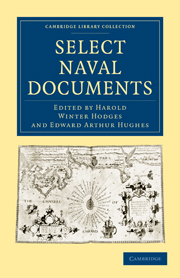Book contents
- Frontmatter
- Preface
- Contents
- LIST OF PLATES
- ILLUSTRATIONS IN THE TEXT
- ABBREVIATIONS
- HENRY VIII
- ELIZABETH
- JAMES I AND CHARLES I
- THE COMMONWEALTH AND PROTECTORATE
- THE RESTORATION NAVY
- WILLIAM III AND ANNE
- THE PEACE PERIOD AND NEED FOR REFORM
- WAR OF AMERICAN INDEPENDENCE, 1778–1783
- REVOLUTIONARY AND NAPOLEONIC WARS
- INDEX
ELIZABETH
Published online by Cambridge University Press: 07 September 2010
- Frontmatter
- Preface
- Contents
- LIST OF PLATES
- ILLUSTRATIONS IN THE TEXT
- ABBREVIATIONS
- HENRY VIII
- ELIZABETH
- JAMES I AND CHARLES I
- THE COMMONWEALTH AND PROTECTORATE
- THE RESTORATION NAVY
- WILLIAM III AND ANNE
- THE PEACE PERIOD AND NEED FOR REFORM
- WAR OF AMERICAN INDEPENDENCE, 1778–1783
- REVOLUTIONARY AND NAPOLEONIC WARS
- INDEX
Summary
The powerful fleet created by Henry VIII was maintained almost at full strength by Edward VI and Mary, but allowed to decline by Elizabeth in the early years of her reign. In the 1570's, however, the views of the experts (especially of Sir John Hawkyns, Treasurer and Comptroller of the Navy) were embodied in a building programme of ships of the ‘middle sort.’ The existence of two schools of thought among builders and seamen, as illustrated in the first extract, must have led to improvements, one of which is described in the second passage. That this clash of opinion (and the supervision of Sir John Hawkyns) led builders to put good material and workmanship into their ships is proved by the testimony of Howard and Wynter.
RACE-BUILT V. LOFTY SHIPS
The Observations of Sir Richard Hawkyns, Knight, in his Voyage into the South Seas, Anno Domini 1593
(Hakluyt Society), p. 1991.Here is offered to speak of a point much canvassed amongst carpenters & sea captains, diversely maintained but yet undetermined: that is, whether the race or lofty built ship be best for the merchant, & those which employ themselves in trading. I am of opinion that the race ship is most convenient; yet so as that every perfect ship ought to have two decks, for the better strengthening of her; the better succouring of her people; the better preserving of her merchandise & victual; & for her greater safety from sea & storms.
- Type
- Chapter
- Information
- Select Naval Documents , pp. 8 - 32Publisher: Cambridge University PressPrint publication year: 2009First published in: 1922



